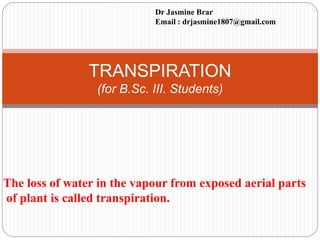
Transpiration
- 1. TRANSPIRATION (for B.Sc. III. Students) The loss of water in the vapour from exposed aerial parts of plant is called transpiration. Dr Jasmine Brar Email : drjasmine1807@gmail.com
- 2. Evaporation Transpiration Water vapours are formed at free surface of water Internal tissues of plant It occurs at surface of non- living objects Exposed surface of plants It is a physical force controlled by environmental conditions like RH & air currents It is both physical & physiological influenced by rate of water absorption, osmotic pressure of cells, thickness of cuticle & stomata It stops when air is fully saturated It continues for sometimes even after saturation due to higher temp. of plant organs exposed to sunlight. Hence, higher saturation point for their internal air
- 3. Evaporation Transpiration Velocity of air currents directly affects it Velocity of air currents indirectly affects it depending upon intensity of light, closure of stomata, bending of leaves Light does not directly affect it Light affect it as stomata open in sunlight & close at night It is faster slow Not influenced by structure of evaporating surface Controlled by anatomy of transpiring organ Not influenced by CO2, hormones, pH It is influenced by CO2, hormones, pH It continues as long as water is available on surface Dependent on absorption of water from soil
- 4. Transpiration Ratio Transpiration is measured in terms of dry matter manufactured by the plant. Water requirement is minimum in case of CAM plants like Pine-apple where the value is 50 units. C4 show a value of 100-200 units, Alfafa 900 units of water For manufacture of single unit of dry matter. Only 0.2 % water is used in transpiration
- 5. Fate of absorbed water (Miller, 1938)
- 6. Stomatal & Cuticular Transpiration
- 9. Closed Open V.S. stoma passing through middle of guard cells
- 10. Arrangement of microfibrils in guard cells Reniform Dumb-Bell Shaped
- 11. Stomatal frequency refers to the number of stomata per unit area of the leaf. The number and distribution of the stomata plays an important role in determining the rate of gas exchange and water loss from a leaf. Salisbury (1928) proposed the term ‘stomatal index’. Stomatal index relates the number of stomata to number of epidermal cells. Stomatal frequency
- 13. Diffusion of water vapours
- 14. External Interference & Resistance Mutual interference in their diffusion shells by neighbouring stomata & resistance in the movement of water vapours by the stationary air layer adhering the transpiring surface
- 15. Transpiration as necessary evil Transpiration is a necessary evil because it is an inevitable process but harmful to plant. Its harmful effects include: wilting, serious desiccation, and often death of a plant, if there is shortage of water. Mild water stress results in reduced growth rate, and reduction in yield. However, transpiration is also beneficial to the plants in several ways. a. Mineral Absorption, b.Turgidity, c. Energy Exchange, d. Effect on Growth and Development, e. Absorption of Water, f. Exchange of Gases